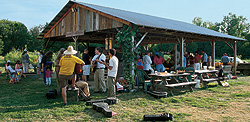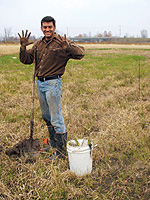


 |
Issue Contents :: Feature Stories :: Fields
Of Dreams :: Page [ 1 2 3 4 ]
While one might not expect to find a liberal-arts degree holder working a plow, many Oberlin graduates have found that growing good food well can be a rewarding and meaningful way of life. "Many of us see farming as a lot more than just farming," says Rachel Dannefer '99, who works with the New York Greenmarket to attract former farmers back into the field. "It's a statement about your lifestyle and values, which are very much in line with Oberlin's values."
 |
|
| Weekly pick-up afternoons offer more than just fresh produce for members of the Intervale Community Farm in Burlington, Vermont. The picturesque setting is also an ideal spot for play and socializing. |
Most Obies who work the land are a bit surprised themselves by their
vocation. "Farming
was never in the plan," says Jones with a bemused smile. "More
than not in the plan. It didn't even make the cutting-room floor." Like
many students, he was introduced to the politics of food through the Oberlin
Student Cooperative Association (OSCA). The farm crisis of the 1980s hit
Lorain County hard, and Jones and fellow student Brad Masi '93 (see
sidebar below), set out to build relationships between OSCA and local
farmers. After graduating, Jones moved to Burlington, unsure of what to
do with his geology degree. He rented a garden plot across the fence from
the then year-old Intervale Community Farm and says he was drawn there
often.
Today, as head farmer, Jones works closely with a board, but he is ultimately
responsible for such tasks as budgeting, harvesting, and providing a
meaningful learning experience for apprentices. He loves the diversity.
" I get to be a grower. I get to be a mechanic. I get to be a planner. I get to be a community organizer and a teacher," he says. "In melon season, I get to be in the field, busting open the fruit and sticking my nose inside. Few things are that tangible." Long-term accomplishments also stand out. "I love that children are excited to come here, that we exist as a community resource," he adds. "The farm will still be here in 50 years, even though I probably won't be. It's to the point where it's gotten a life of its own."
On this autumn pick-up day, Jones seems to be everywhere at once. He beams at a new baby, heaves another case of spinach up onto a table, offers advice to a neighboring farmer about cover crops, and explains how to cook celery root. A 3-year-old approaches him, asking shyly, "Why do you wear overalls?"
Jones thinks for a moment before explaining. They keep him cleaner and cooler, he says, adding—as he digs out a seemingly endless flow of fascinating gadgets—"they have lots of pockets."
|
The Intervale Community Farm was named Vermont's Sustainable Farm of the Year in 1999, earning it media coverage in such outlets as The Boston Globe and Organic Gardening. "What's phenomenal about Andy is that he sees the flowers through the weeds," says Enid Wonnacott, executive director of Vermont's Northeast Organic Farm Association, of which Jones is board president. "He's a highly skilled production farmer, but he has a much bigger vision of the role that farming plays in Vermont and around the globe."
It is this ability—to grow good food while working toward broader
goals—that distinguishes many Oberlin farmers.
Take Jennifer Greene '87, for example, who owns a grain, bean, and
seed CSA farm in Fort Jones, California. Every month, the 100 members
of Windborne Farm receive large cloth sacks holding freshly stone-ground
whole wheat flour, pancake mix, and a cereal blend. Members also get unusual
grains like amaranth and teff, which Greene has carefully tested for their
ability to thrive in northern California. In contrast to agribusiness
farms—which grow only the few types of corn or potatoes demanded
by national food processors—Greene grows corn and beans of every
shape and size, from bright fuchsia Indian Red Vine lima beans to tiny
white Texas Cream cow peas. Draft horses handle the majority of her cultivation
and weeding, and she's determined that the farm not grow beyond
what she alone can handle. "Whatever I can do, I do," she
says. "I don't want to be managing people. I'm really
focused on the farming."
In western Massachusetts, Michael Docter '84 runs a CSA farm on
a very different scale. Food Bank Farm has 660 paying shareholders and
donates fresh, organic produce—about 150,000 pounds per year—to
the Food Bank of Western Massachusetts. Docter started the farm nearly
15 years ago as an employee of the food bank, but he now operates it independently
and leases the land. The project has served as a model for similar operations
across the country.
"Farming was something I always wanted to do," says Docter, who believes
that public service farms are the ideal way for young people to get involved
in the profession. "But I never understood how someone who didn't
own land and didn't know how to farm could become a farmer." Food
Bank Farm depends on five or six apprentices each year. "We strive
to teach them the skills and knowledge that they will need to run their
own farms one day," he says.
